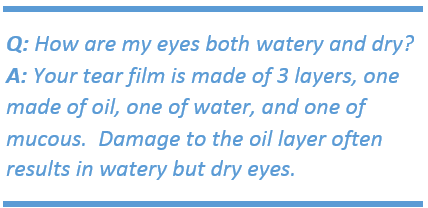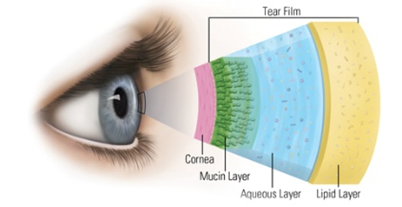Dry Eye Syndrome
 Dry Eye Syndrome (aka Keratoconjunctivitis sicca) is a condition in which there are insufficient tears to lubricate and nourish the eye. Tears are necessary for maintaining the health of the front surface of the eye and for providing clear vision. People with dry eyes either do not produce enough tears or have a poor quality of tears. Dry eye is a common and often chronic problem. Your symptoms of Dry Eye may include: dryness, scratchiness, burning, and redness, a sensation that sand is in your eye or blurred vision. At our office, we execute over 10 methods of improving our patients dry eyes. During your examination we will determine which methods are best for you.
Dry Eye Syndrome (aka Keratoconjunctivitis sicca) is a condition in which there are insufficient tears to lubricate and nourish the eye. Tears are necessary for maintaining the health of the front surface of the eye and for providing clear vision. People with dry eyes either do not produce enough tears or have a poor quality of tears. Dry eye is a common and often chronic problem. Your symptoms of Dry Eye may include: dryness, scratchiness, burning, and redness, a sensation that sand is in your eye or blurred vision. At our office, we execute over 10 methods of improving our patients dry eyes. During your examination we will determine which methods are best for you.Causes of Dry Eye
 Environmental conditions — Exposure to smoke, wind, dryness, air conditioning, or failing to blink regularly, such as when staring at a computer screen can increase tear evaporation.
Environmental conditions — Exposure to smoke, wind, dryness, air conditioning, or failing to blink regularly, such as when staring at a computer screen can increase tear evaporation.
Medications — Antihistamines, decongestants, blood pressure medications and antidepressants can cause dry eye.
Medical conditions — Rheumatoid arthritis, diabetes and thyroid problems are more likely to have dry eye.
Contact Lens Wear — Long term wear, improper hygiene and care for contacts, or certain contact lens brands.
Blepharitis — Inflammation and infection of the eyelids
Trichiasis — The inward turning of eyelids or lashes can cause dry eyes.
Meibomian Gland Dysfunction — Reduced oil output to the tear film.
Pinguecula / Pterygium — raised thickening of the conjunctiva on the white part of the eye, due to sun and wind exposure can cause dryness, redness or itching and may become inflamed.
Age — Dry eye is a part of the natural aging process. The majority of people over age 65 have dry eyes.
Gender — Women develop dry eyes due to pregnancy, the use of oral contraceptives, and menopause.
Post-Surgery — LASIK, PRK, and other eye surgeries.
Treatment Plan
Individualized to you depending on the cause and severity of your condition. Your optometrist will recommend some of the following:
| Restasis Eye drops | A prescription medication to fight inflammation and help your body create more of your own tears. |
| Lotemax Eye drops | A prescription steroid that gives fast acting relief for episodic dryness. |
| Gel/Ointment | For patients with lagophthalmos- Allows the front surface of the eye, the cornea, to heal while you are asleep. |
| Artificial Tears | Keeps the eye lubricated during the daytime. Tears are the most natural way to improve dryness, but frequent use of these drops for marginal improvement in symptoms can become frustrating for most patients. |
| Contact Lens Wear | Soft contacts often cause dryness. You may need to limit wear time, removing contacts 1-5 hours before bed, or wearing them only 2-6 days per week. |
| Lid Hygiene | If your eyes have excess bacteria flora, you may be asked to clean your eyelids with Ocusoft Lid scrubs or 1:1 baby shampoo to water. |
| Warm Compresses | To clear impacted oil glands, you may need to use heated compress over the eyes then massage the eyelids. |
| Omega 3 Vitamin | Patients with meibomian gland dysfunction may benefit from Omega 3 vitamins. |
| Punctal Plugs | Plugs inserted by your Optometrist in the office to help reserve more of your tears. |
| Anti-Allergy Drops | Drops that fight itching and watering that sometimes occurs in congruency with dry eye. |
| Hybrid Contact Lenses | Soft contacts dry your eye out, but scleral and hybrid lenses protect your eye from dryness. For some prescriptions, these lenses will also allow you to see better than traditional contact lenses or glasses. |
